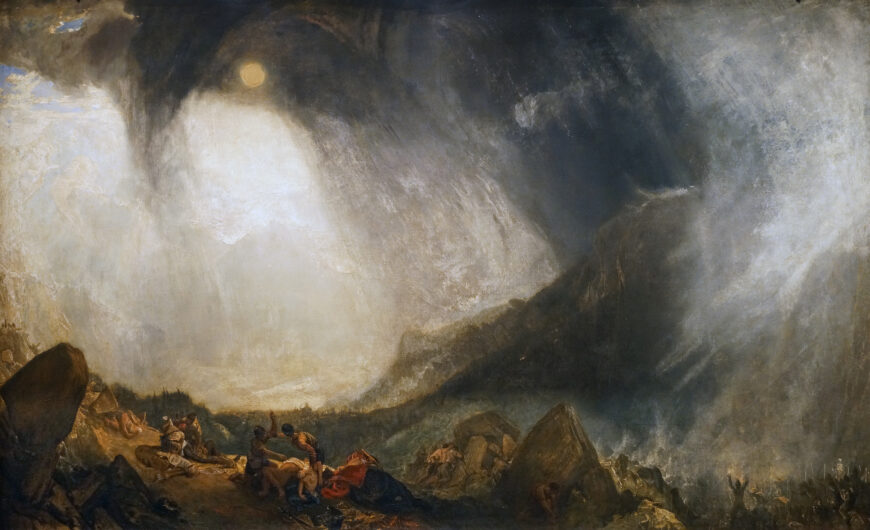
Joseph Mallord William Turner, Snow Storm: Hannibal and his Army Crossing the Alps, exhibited 1812, oil on canvas, 146 x 237.5 cm (Tate Britain, London; photo: Steven Zucker, CC BY-NC-SA 2.0)
Joseph Mallord William Turner’s Snowstorm: Hannibal and his Army Crossing the Alps confronts us with a harrowing scene. Tiny figures scatter among the jagged rocks of a pass through the dangerous mountains of the Alps. In the foreground, they crouch in fear, faint from panic as they are attacked by other figures, or try to wedge themselves into gaps between boulders for shelter. In the mid-ground, the hazy forms of others raise their arms in terror as they look up at the sky. The background makes plain the reason for their terror: a massive black storm cloud rises up from the right and curls over and around the sun. A blast of snow-laden air rushes in alongside it. Together, the swirling vortex of the storm and the column of frosty air threaten to annihilate the fragile human forms.
Although the figures in Turner’s painting find themselves in a scene of fear and confusion, the artist’s Snowstorm gives us a clear window into the art, culture, and politics of 19th-century England. Amidst the boulders of the mountain and the haze and snow of the storm, we find an expression of the artist’s hopes for his chosen art form—and for the outcome of one of the most significant wars in European history.
Turner’s sublime Romanticism
Turner’s Snowstorm aligns with the “sublime” aesthetic in art. The sublime was one of three major ways of depicting landscapes in the early 19th century. The “beautiful” was pleasurable, soft, and calm. The “picturesque” presented objects of interest in a tranquil scene that had some degree of rustic roughness. The “sublime,” however, inspired terror through immense scale, darkness, and other effects meant to make the viewer feel threatened. In the early 19th century, all these modes were popular, but the sublime was favored by one of the most influential movements of the period: Romanticism. Snowstorm, with its terrifying storm and evocation of helplessness, falls neatly in line with sublime aesthetics and the subjectivity of the Romantic style.
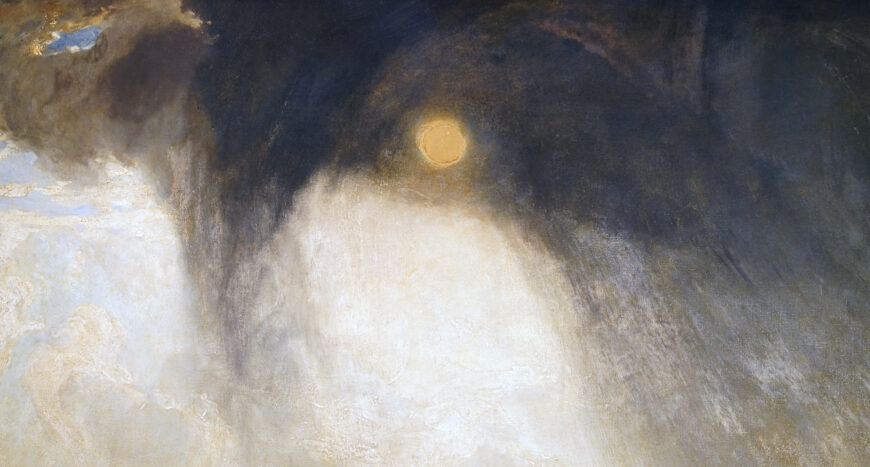
Swirling snowstorm meant to evoke the sublime (detail), Joseph Mallord William Turner, Snow Storm: Hannibal and his Army Crossing the Alps, exhibited 1812, oil on canvas, 146 x 237.5 cm (Tate Britain, London; photo: Steven Zucker, CC BY-NC-SA 2.0)
Turner was a leading figure in English Romantic art. His status was due, in part, to his many inventive compositions. We see one of the most exciting of his innovations in Snowstorm: the compositional vortex. The approaching storm’s arc around the sun appears to twist back around on itself, as if creating a spiral. The curve of the cloud echoes the curve of the rocky ground, which extends this spiral throughout the entire composition. Turner often used this device in depictions of storms to convey the power of nature and to make viewers feel as if they were in the middle of the tempest itself. Some of the most dramatic examples of his compositional vortex were created during his later career, when he began to experiment even more radically with form. However, even by 1812, Snowstorm’s swirling composition demonstrated his enthusiasm for the sublime mode and desire to reinvigorate landscape painting.
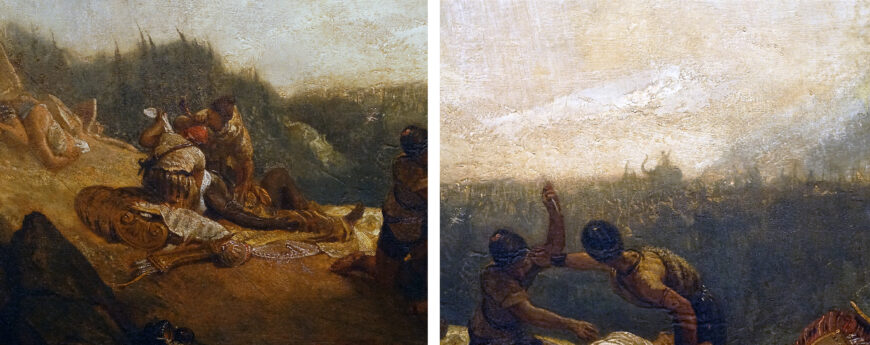
North African soldiers in left foreground (left detail) and General Hannibal riding an elephant (right detail), Joseph Mallord William Turner, Snow Storm: Hannibal and his Army Crossing the Alps, exhibited 1812, oil on canvas, 146 x 237.5 cm (Tate Britain, London; photo: Steven Zucker, CC BY-NC-SA 2.0)
The historiated landscape
One of the ways Turner increased landscape painting’s prestige was by depicting famous scenes from history. As we look closer at the painting, we notice details that tell us more about its setting and subject. The men in the left foreground have dark skin typical of a North African civilization, ancient shields are strewn about the ground, and the faint outline of an elephant with its trunk raised to the sky appears on the distant horizon. By including these elements, Turner was able to layer a famous event from ancient history onto his sublime landscape. The “Hannibal” of the painting’s full title was a famous Carthaginian general. During Hannibal’s lifetime, Carthage was at war with Rome. One of the most famous events from this conflict was Hannibal’s invasion of Rome, a feat he accomplished by passing through the mountain range shown in the painting. He famously led not only soldiers, but also approximately three dozen elephants trained to fight in battles across the treacherous mountain pass. Here, Turner imagines the famous general’s army as they make their way through the pass and find themselves vulnerable to unpredictable Alpine weather.
The artist’s allusion to the ancient past would have helped to raise the prestige of this work. Before this period, landscapes occupied a low place on the hierarchy of genres. At this time, the most celebrated genre of art was history painting, which portrayed scenes from the ancient past, the bible, or mythology. History paintings used elevated subjects and modeled moral behavior for viewers, attracting the favor and approval of critics. Turner and other landscapists often elevated their landscapes by inserting scenes from history or legend into their landscapes, making historiated landscapes. Historiated landscape painters were shielded from accusations that they lacked education or the ability to convey elevated ideas by the simple fact that their work included respected narratives that carried important moral meanings.
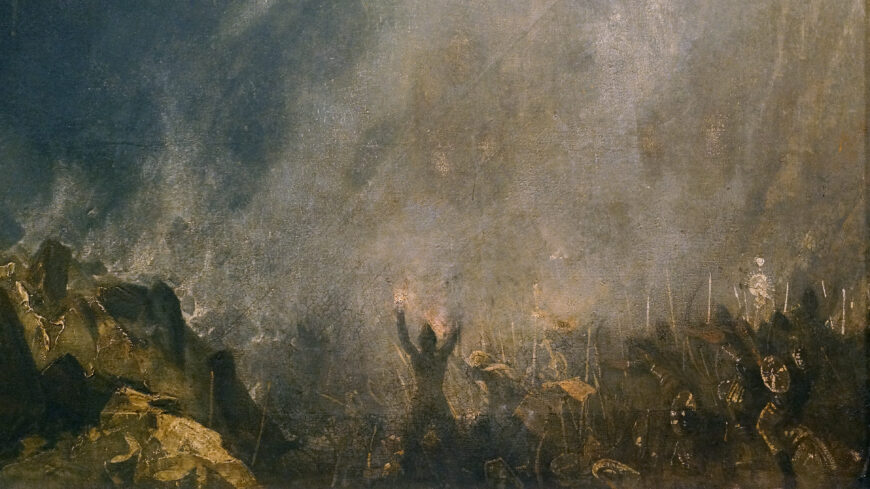
Soldiers fighting against the snowstorm (detail), Joseph Mallord William Turner, Snow Storm: Hannibal and his Army Crossing the Alps, exhibited 1812, oil on canvas, 146 x 237.5 cm (Tate Britain, London; photo: Steven Zucker, CC BY-NC-SA 2.0)
A coded message
In 1812, the year Turner completed Snowstorm, the painting would have invited multiple interpretations. As we have seen, its use of the sublime conveyed the power of nature, but other details suggest a more pointed and timely message. History tells us that Hannibal traveled alongside the war elephants during the Alpine crossing. In Turner’s painting, we see him far in the distance, riding the elephant that raises its trunk near the horizon. What Turner chose to emphasize, instead, is the horror and mortal peril experienced by the soldiers who follow the general. This decision invites viewers to consider how everyday soldiers are made vulnerable to catastrophes because of their distant, disconnected leaders.
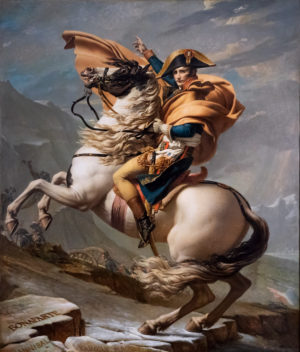
Jacques-Louis David, Napoleon Crossing the Alps or Bonaparte at the Saint-Bernard Pass, 1800–1801, oil on canvas, 261 x 221 cm (Chateau de Malmaison, Rueil-Malmaison)
Turner’s decision to give “Hannibal” the focus in his title—but not his painting—helps us to understand why he might have portrayed this theme. Historiated landscapes were often understood not just as scenes of the distant past, but as coded commentaries on the present. When Turner was working on this painting, England was locked in a bitter war against the French Emperor Napoleon Bonaparte. The war was so disastrous that, by some estimates, it claimed the lives of approximately five million people throughout Europe. In the early 19th century, the Emperor was frequently referred to as the “modern Hannibal” because he, too, had invaded Italy by crossing over the Alps. In fact, a little over a decade before Turner painted Snowstorm, the French painter Jacques-Louis David famously portrayed Napoleon crossing the Alps while sitting calmly astride a rearing horse. Below the horse, stones with Bonaparte’s and Hannibal’s names make clear the connection between Napoleon and his ancient predecessor. We can, therefore, understand Turner’s ancient scene as an allusion to Napoleon and his wars of conquest as an engine of destruction—not unlike the snowstorm itself. Further, the devastation of Hannibal’s army stands in for Turner and his English countrymen’s fervent wish that Napoleon and his army will soon fall.
The artist’s decision to use a snowstorm to express this hope now seems almost prophetic: the French army would suffer severe losses due to winter storms when Napoleon invaded Russia in 1812—less than a year after Turner began his work. For this reason, we can understand the painting as an all-too-timely commentary on the French emperor’s irresponsible leadership. Even without this coincidence, however, the painting remains vital to understanding the major artistic and historical currents of the early 19th century thanks to its terrifying use of the sublime and the multi-layered implications of its historiated landscape.

